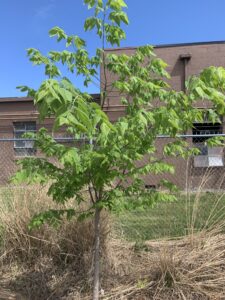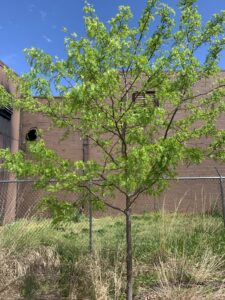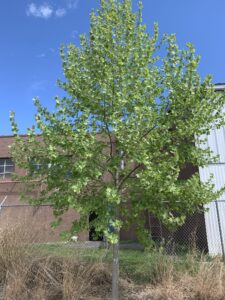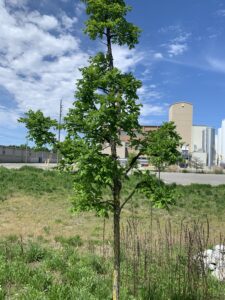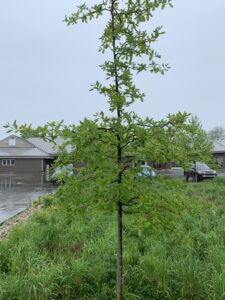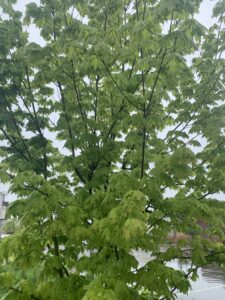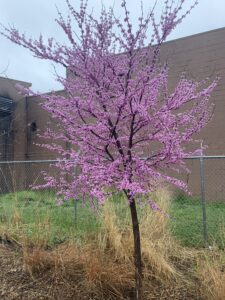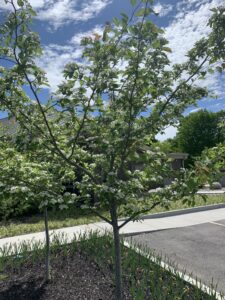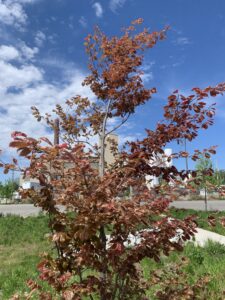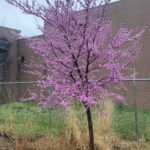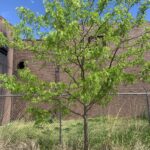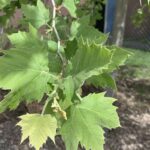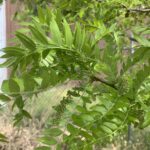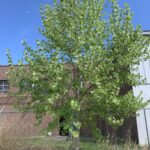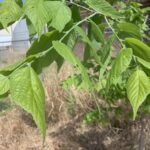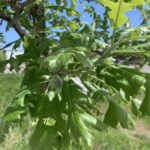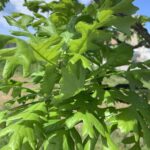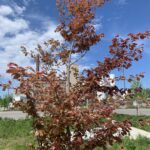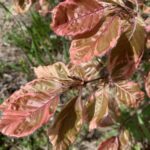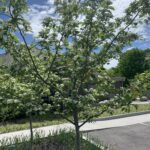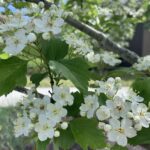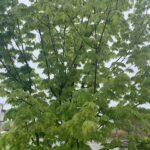On May 12, 2019, we gathered in our church parking lot to plant trees. In his sermon that day, Aaron Sawatsky-Kingsley, city forester, introduced us to our new trees, each with it’s own personality:
Hackberry
Wild early, but matures with grace, a bit of an ugly duckling. This is the kind of tree that is always drawn to the dangerous edge, is looking for the dark, swampy stuff in the floodplain – if it wasn’t already growing there. Grows its hair out, cuts it crazy, dyes it, gets into heavy metal and cigarettes too early, and probably gets into some trouble, too. It’ll spend a decade, maybe two, sorting itself out, but then one day, you’ll turn around and realize it’s turned into something quite extraordinary. The roughness is still there, and the scars, and the signs of turmoil, but this tree will craft it all into strength, and a quiet and attractive self-assurance that only comes from lived experience.
Honeylocust
Unruly and a prankster, keeps a great sense of humor. A running-mate of the hackberry and a great friend. Every bit as crazy in its youth, willing to try anything, take on any situation, thinks its going to live forever, and so tends to be careless. Also has a wicked, twisted, sharp sense of humor – you don’t want to cross a honeylocust. But at the same time, one of the most loyal, most faithful friends – bonds will endure a lifetime. As will its sense of humor. This is a tree which is as glad for a dirty joke or a prank as it is for a surprise April-Fools snow shower, and will be laughing as lustily at 80 as it was at 8.
Sycamore (London planetree)
A little aloof and self-absorbed, a little hard to get to know, but generous and quite open-hearted. A pretty tree all the time, and occasionally – in the right light or the right season – actually beautiful. A quintessential homecoming-king-slash-queen-slash-jock of a tree. The problem is, it knows it, and really enjoys the attention. Sycamore can be thin skinned, and lacking in self-confidence, so if it’s not being admired, its’s not really sure what good it is. Which leads some people to think it’s arrogant. What it really wants more than anything – even more than being admired – is companionship: good, solid relationships. So if you’re willing to look beyond its good-looks, you usually find a very generous and open-hearted tree.
Bur Oak
Slow and steady, comes into its own late, stately and grand. There is really nothing much to notice about a bur oak early on, other than that it will begin to produce a knobby, warty kind of bark between four and seven years of age, the way some teenagers get an unfortunate dose of acne. Not the kind of thing you want to be noticed for. Otherwise, its just a tree, going about its tree business, not really concerned about what anyone else thinks of it. Not pushing any boundaries, not breaking any rules, not looking for any spotlight. And this is pretty much the way it goes about its life for 40, 50, 60 years. But then there comes a slow dawning moment, when someone looks up at this tree, and points, and says something to someone else, and a few others notice it then, too, who show it to others, and they all say something like, “Hm. When did all that happen? When did that tree become so stately, so grand, so…amazing?” And after that, no one will remember that for most of its life it was just a very unremarkable brown tree with green leaves.
Black Tupelo/Gum
Shy, uncomfortable with itself, hates to be noticed, but turns out to be brilliant when it comes into its own. Its hair is never right; it always sticks out. Clothes are always a year behind the style. Black tupelo starts out stunted and small, doesn’t want to be noticed, but has a bad habit of sneezing too loud, which makes everyone laugh. And then it turns bright red (especially in the fall), which makes this tree even more noticeable. Mostly, it just wants to disappear into the background. But all the quirkiness, all the weird right angles, all the wiry and clumsy growth, and the awful blushing, slowly begin to work together. It may take a long time to realize it, and it doesn’t help that the black tupelo is a bit of a loner. Its few friends are the ones that begin to see it in the first place, long before the black tupelo does, and they try to point it out, that, hey, you’re pretty cool. And eventually, it comes around to it, with a refreshing ability to poke fun at itself in a way that isn’t a passive ploy to get others to pay compliments. Black tupelo inhabits itself with a rare kind of honesty.
Black Maple
A natural star, like most maples, envied by others, though its hard to say exactly why. That’s kind of the way maples are: they’re just perfect, just born that way, great structure, great coloring, great family, great neighborhood, great car, great time last weekend. Everybody’s always hanging around, always want to be with a maple. Famous for being famous, like a Kardashian. The question is why? Well, they do look good – there’s no way around it. And that’s no fault of its own. It can’t help being a maple. Its just that to the rest of us, who wish we were a black maple, or any kind of maple, it seems more than a little unfair that some get all the breaks just for being born. Oh well, even the maples are god’s children.
Red Bud
Gregarious, almost to a fault. Always chipper, always excited, always on a caffeine buzz or a sugar high. And always seems to show up, even if it… wasn’t…exactly…invited. But there’s really no harm, not really. Most of the time red bud is a lot of fun, and most of the time its just as happy to make sure others are having as much of a good time as it is. Red bud also makes everybody else look good. While everybody else seems to grow up and shed their childhood, red bud has an uncanny ability to tap into its young energy – and not in an annoying way – but in a way that reminds everyone else that you have to lighten up every once in a while and go jump in a really muddy puddle.
Hawthorn
A hard one to understand, seems finicky and complicated, but turns out to be tough – and lovely. Hawthorn is true to its name: the fruit – a haw – is a lot like an apple, but doesn’t have much flavor to speak of; and the thorns are serious (even if they are only figurative ones, since the real ones have been bred out of our particular hawthorns). You know the type – all this drama, all this baggage, but where did it come from, and why can’t it just get over it? And there is a lot of drama early on, fits and rages and blights from time to time, possibly some galls, seems like its always looking for a fight or a reaction. But every now and then you catch a glimpse of something completely serene, a moment of flowering – real, honest-to-god flowers – that it covers itself in. Or it may be those haws, which in spite of their uninspiring taste, are jewel-bright, especially in the winter. And the birds don’t seem to care what they taste like by late winter. Hawthorns settle slowly into themselves, and as they do their bite becomes more of a bark, and the bark really becomes more of a friendly-and-yet-penetrating shout-out, that makes you think, “Oh, that tree knows some stuff about the world I should know, too.”
Tri-color Beech
A true beauty, and a little embarrassed by it. Its beauty is undeniable. And its actually enhanced by the fact that its beauty is not a preoccupation for itself. In other words, it doesn’t go out of its way to advertise itself or to make anyone look. When you’re in the presence of a Tri-color Beech, you just can’t help noticing. And commenting. Its this way from the beginning, and continues through its life. Slowly it spreads long, sinewy-smooth branches and arching limbs, tipped in variegated leaves of white, pink and burgundy. Eventually it becomes a place where people can perch as easily as birds; and its unusual architecture, its unbalanced bone structure, makes it more appealing, rather than less, as in other trees. And its skin tone remains silky smooth. Though its individual characteristics are audacious and seem ridiculously over the top, they are so well put together in this one body, that they mute and compliment and blend into something subtle, and quite close to sublime. And if that weren’t enough, it’s also a very intuitive conversationalist.
- Red Bud
- Honeylocust
- Sycamore
- Honeylocust
- Sycamore
- Hackberry
- Hackberry
- Bur Oak
- Bur Oak
- Bur Oak
- Tri-Color Beech
- Tri-Color Beech
- Hawthorn
- Hawthorn
- Black Maple


